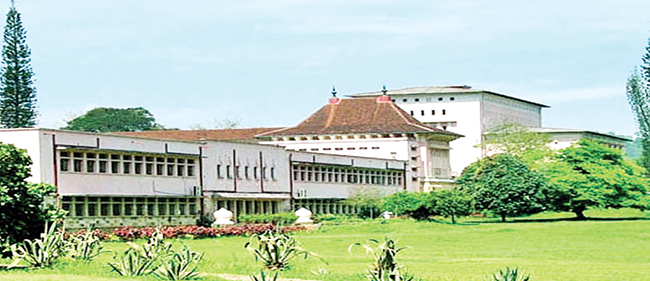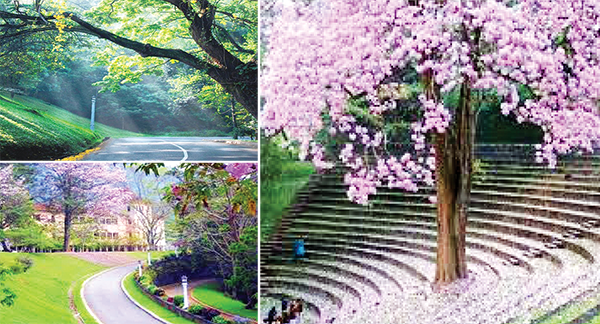Features
Reminiscence of Peradeniya Campus in the Sixties

by Prof. R.P. Gunawardane
A very interesting article, ‘Ceylon’s first university in memory and imagination’, by Ernest Macintyre in The Sunday Island of 12 February 2023 describing the life at University of Ceylon, Peradeniya Campus in fifties prompted me to write about the life at Peradeniya Campus in the next decade, the nineteen sixties.
Macintyre has elegantly described the life at Peradeniya Campus in the early years after its establishment in 1952. At the time only the Faculty of Arts and Oriental Studies was functioning at Peradeniya. The other faculties were established later in the early sixties.
In the sixties there were five faculties on the Peradeniya Campus— Arts, Medicine (including Dental Surgery division), Agriculture (including Veterinary Science), Science and Engineering.
Most students were accommodated in halls residence. For boys the Jayathilake, Wijewardana, Arunachalam, Mass, James Peiris, Marcus Fernando, Hilda Obeysekera and Akbar-Nell halls were available. The Ramanathan and Sangamitta halls were available for girls at the time. However, when the number of girls entering the university increased in subsequent years and due to other reasons, the Hilda and Wijewardana halls were converted into female hostels.
At the time, all food and laundry services were provided by the halls. The hall fee was only about Rs. 250 per term (for about three months). Food was excellent with nicely arranged tables serving breakfast, lunch, evening tea and a superb dinner. At the time we used to get fried rice and chicken curry for lunch on Sundays, even the visitors were allowed to enjoy food in halls.
In the sixties most of the elite as well as other well to do students in and around Colombo entered the University of Ceylon, Colombo Campus for convenience and also to remain in the Colombo environment. On the other hand, the outstation students mostly from the south and the north and also from the east and the Central Province including plantation sector all entered Peradeniya campus. In the south, most of the students came from Galle and Matara districts. Most of them except a few very rich ones who came with their parents in private cars, travelled to Peradeniya by train and by bus.
I remember travelling by the train, Ruhunu Kumari, from Weligama railway station to proceed to Peradeniya on 4 October 1965. I had nobody to accompany me because both my parents were dead. I was joined by several senior students who entered the university previous year from my school at the Galle Railway Station and travelled with me to Peradeniya. In fact, a friendly low-key form of ragging started in the train itself asking various funny and interesting questions by some seniors. We changed trains in Colombo Fort to Udarata Menike and got off at Kadugannawa. Udarata Manike goes to Nanuoya via Kadugannawa and it does not run to Kandy via Peradeniya. We had to travel to Peradeniya by bus from Kadugannawa and it was fortunately a short journey.

There was no body to receive us at Peradeniya and the university had not organised any vans to take us to the halls as in the 1950s described by Macintyre in his article. We had to carry our bags and walk to the halls. My senior friends from our school helped me carry my bags to Jayathilake hall. Since I had visited the Peradeniya campus previously in April the same year for my practical exam, I was familiar with the area and it was easy for me to reach the destination.It was very convenient to stay in Jayathilake hall because all my classes were held in the Faculty of Science, situated just opposite Jayathilake hall on the other side of the Galaha road.
The Peradeniya campus was huge with about 700 hectares of land. On one side we could see the Hanthana mountains and on the opposite side the longest river in the country, the Mahaweli.Although some blame the change of language policy for the lowering of standards in the university, this claim cannot be justified. This change of policy gave tremendous opportunities to many deserving rural and underprivileged students across the society in all the communities – Sinhala, Tamil, Muslim and all other minority communities to enter the seats of higher learning. Most of them picked up so fast and became fluent in English.
In the science stream, (all sciences including medicine engineering, etc.) students had to change over to English medium at GCE A/L or in the first year at the university. This transition was not easy but most students managed to get over difficulties.
Peradeniya was a paradise for youngsters awaiting to enjoy life away from home and for lovers who found partners on the campus. A fair number of students found their partners during the first year. Some others waited for the new train to arrive – the next year batch! There were some who were very shy and avoided these opportunities to meet partners. I believe they waited for their parents to find the partners at the appropriate time! Some say they missed the bus. Some found partners in the same faculty easily while there were many interfaculty couples at the time.
There were many opportunities to meet partners on the campus. Parties and dinners in the halls; badminton and volleyball matches were organised by various groups in the faculties, halls of residence and sometimes outside the campus in Kandy and Botanical Gardens, Peradeniya. My friend Wije, a medical student from my hometown, found his girlfriend at Hilda Hall. His family is now living in England.
My girlfriend in the school in Galle (later my wife) entered the Medical Faculty of the Peradeniya University the following year and joined me. We fully enjoyed the campus life.
We used to have regular parties in and outside the campus. I can very well remember a party held after selection to follow a Special Degree in Chemistry in 1966. We held the party in the Botanical Gardens with all kinds of drinks including beer and arrack and food. Most of the boys were drunk at the end of the event and some were carried to their halls of residence!
The city of Kandy is only four miles away; bus fare was only 25 cents, and red Mercedes Benz buses were shuttling between Kandy and the campus. The journey took about 15 minutes. Many small parties and get-togethers were held in small venues and in restaurants in the Kandy town. I can remember going to Chinese restaurants along Dalada Veediya and Lyons Café near the Police Station. Visits to movie theatres in Kandy were very common with girlfriends. There were four movie theatres in Kandy. The Regal theatre in Mulgampola along Peradeniya road was popular at the time showing Hindi, Sinhala and English movies. University couples were seen in these theatres very often. They had more freedom in these theatres than along the Kissing Bend because darkness in the theatres provided more opportunities to gratify their desires.
Expedition and climbing Hanthana mountain range is again popular on the campus. Couples and groups of students used to do this expedition at least once during their campus life. I did it once with some of my friends only males and a few lecturers also joined, giving us more confidence. It was beautiful scenery and a very enjoyable visit.
During campus life at Peradeniya, most students visited Sri Pada. We also did so once with one lecturer accompanying us. We went by train from Peradeniya to Nanuoya and then took a bus to the base of Sri Pada. We climbed all night and reached the top in the early morning, witnessing the beautiful scenery of the sun rise from the top of the mountain.
The Kissing Bend, the Lover’s Lane, the open-air theatre are very interesting spots for the students and particularly for the young couples. Kissing bend is on the Galaha road just opposite Hilda park after passing the Lodge on the left if one travels towards Galaha from the main campus. In the evening, this bend is dark because of the huge trees around making it easier for boys to kiss their girls. Unfortunately, in later years this road became very busy with too much traffic and pedestrians.
The Lover’s Lane is situated between the Senate, administrative and library building complex and the Mahaweli Ganga. It starts near the Kissing Bend on Galaha Road runs along the bank of Mahaweli. It is a lonely winding road overlooking Mahaweli with minimum traffic or pedestrians giving complete privacy to the youngsters. You see many couples along this path in the evenings. If you need more privacy you may go down to the bank of the river and sit on a rock. You see many couples doing that in the evening. It is also possible to go down to the bank of the Mahaweli river through the Hilda Park. Bank of the river has a number of huge bamboo bushes spread over a long area. One could witness many couples sitting under bushes maintaining privacy.
Dramas and musical shows were held regularly in the Open Air Theatre in Hilda Park. This is commonly known as “Wala”. Every year there is a Drama Festival lasting about one week those days having different very popular dramas like ‘Maname’, ‘Sinhabahu’ in the evenings. Students called this “Wale Sellam” means playing in the hole. This was a very interesting event and many students and the couples including staff members attended these events. Musical shows also were held regularly at the gymnasium inviting famous singers at the time. Pandith W.D. Amaradeva was a frequent visitor those days.
Peradeniya University is a national treasure in this country. Thus, it should be preserved and further developed, maintaining its unique features for posterity.